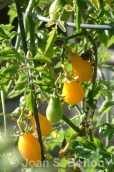
Warmth, moisture and soil. And a touch of sunlight.
On the surface, those are the simple requirements for almost any seed to sprout. Nature has performed the miracle for millennia, so how hard can it be?
Indeed, growing your vegetables from seed is not difficult. It does require patience, and there are a few immutable steps that you must follow. But the beauty is that you won’t be limited to the seedlings that your nursery stocks. Plus, you’ll have a wide-open door to the vast world of heirloom vegetables.
What’s an Heirloom?
Heirloom vegetables are part of a grand tradition, a link to earlier, agrarian times, when seeds were passed from neighbor to neighbor. They are open-pollinated plants, meaning they either self-pollinate by bearing both male and female flowers, or cross-pollinate when wind, insects or water carries pollen from one plant to another.
Heirlooms pre-date the early 1950s, when scientists began hybridizing plants, pollinating them in laboratories to achieve specific goals. Those might be to create vegetables with thick skins to withstand mechanical harvesting, hold color on their multi-day journey from field to market to table, bear larger yields or resist disease.
Unfortunately, those efforts may come at the expense of what’s my bottom line — flavor. In addition, seeds borne by hybrids rarely produce plants that resemble the parents.
That’s where heirlooms come in. The offspring of open-pollinated vegetables is consistent. As for quality and taste, gardeners most likely have saved seeds of their favorites. So if the plant has been passed down for more than a century, odds are, it’s still a good bet today. Look no further than Brandywine, Green Zebra and Yellow Pear tomatoes; Scarlet Runner beans; and Moon and Stars watermelons. Heirlooms all, they thrive here and produce amazingly perfect, tasty crops.
Getting Started
Summer vegetables, including tomatoes, beans, corn, cucumbers, eggplants, melons, peppers, pumpkins, squash and tomatillos, need at least six to eight hours a day of direct sunlight. They also insist on loose, loamy soil that’s brimming with fully composted, organic material that drains fast. Given the heavy clay that predominates on the South Coast, it’s best to plant your veggies in raised beds, where you can enrich the soil. If that’s not possible, heavily amend and mound up your vegetable area to enhance its fertility, tilth and drainage.
You can sow your seeds directly in the garden. Vegetables from larger seeds, such as beans, corn, melons, pumpkins and squash, sprout easily and send down roots quickly.
But containers provide better control over the initial planting medium, moisture, warmth and light. They also make it easier to protect delicate seedlings from opportunistic birds.
Use flats, pony packs, 4-inch pots or anything else that holds at least 3 inches of planting mix and has drain holes. Fill your containers with light, fast-draining material. Garden dirt is an absolute no-no, as it’s too heavy and won’t allow enough oxygen to reach newly emerging roots. Don’t use straight potting soil, either. Instead, mix it with generous amounts of perlite, vermiculite or other “soil-less” ingredients, such as peat moss.
Water the mix before sowing your seeds. Use a pencil or screwdriver to poke appropriately deep holes. Drop in the seeds. Sprinkle planting mix on top. Mist with water. Then enclose with clear plastic to hold in humidity. Use straws or bamboo skewers to keep the plastic from collapsing on the mix. Place the setup in a warm spot with bright, indirect light.
Remove the plastic when your seedlings sprout. In the meantime, let the surface go dry between waterings. If kept wet, damping off may raise its ugly head. The fungal disease causes precious seedlings to topple and die.
Transplant your seedlings to the garden once they’ve developed several sets of leaves.
When to Plant
In much of the country, sowing is linked to frost dates. But our frost season is so brief — in Santa Barbara and the coast, from early December to late February, and inland and in the Santa Ynez Valley, from mid-November to mid-March — that it has little impact on summer vegetables.
Our timing is such that the first veggies can go in the ground in April or May. Backing up the calendar a month to account for sowing and sprouting puts us in March or April. So we’re clear of any frost issues.
But do wait until May to start eggplant or pepper seeds in containers. Those two, along with melons, prefer warmer night-time temperatures. All three are better off if they aren’t set out in the garden until June.
An additional consideration when deciding when to plant heirlooms has to do with open pollination.
Different varieties of vegetables that cross-pollinate, such as beets, carrots, corn, cucumbers, melons, squash and pumpkins, must be isolated to ensure that the offspring remains true to the parents. Or you can plant different varieties at three to four week intervals, so that their flowering doesn’t overlap.
Self-pollinators, such as beans, eggplant, lettuce, peas, peppers and tomatoes, are easier. You can grow different varieties side by side and reasonably expect that their offspring will remain true.
Saving Heirloom Seeds
Toward the end of the season, select several of your favorite plants and let their fruits ripen beyond the point of no return. While specifics vary between crops, essentially you dry the seeds in single layers on paper towels indoors, then store the seeds in air-tight containers in a cool, dry place until the following year.
≈
This article was first published in the Spring 2010 issue of Edible Santa Barbara.
Copyright, Joan S. Bolton. All rights reserved. Reproduction of text or photos in any form is prohibited without written permission.
≈
